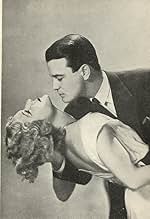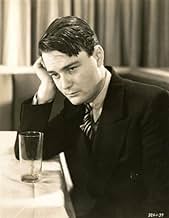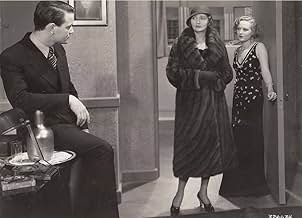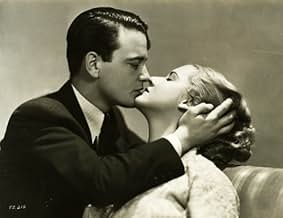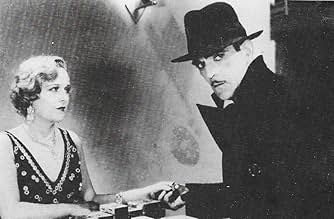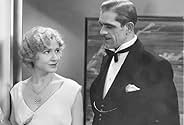Aggiungi una trama nella tua linguaStory of the goings-on at a Prohibition-era nightclub.Story of the goings-on at a Prohibition-era nightclub.Story of the goings-on at a Prohibition-era nightclub.
- Regia
- Sceneggiatura
- Star
Alice Adair
- Chorine
- (non citato nei titoli originali)
Consuelo Baker
- Chorus Girl
- (non citato nei titoli originali)
Frank Beal
- Bit
- (non citato nei titoli originali)
Louise Beavers
- Maid
- (non citato nei titoli originali)
Recensioni in evidenza
You can certainly tell that "Night World" is a pre-code picture. It's set in a speakeasy--just the sort of sordid locale that wouldn't have been allowed after the new Production Code went into effect in mid-1934. Of course, by then alcohol was legal and speakeasies were a thing of the past anyways. The film is very much like a soap opera--with a variety of folks and love affairs going on during the course of the picture.
Several story lines are going on at the same time in this film and at then end, they all converge. One story is about the owners of the club, Happy (Boris Karloff) and Jill. However, Jill is cheating on her hubby and the way this story ends is pure dynamite. The main story involves a young man who's been drinking himself into oblivion (Lew Ayres). Why and his relationship with a girl who works in the club (Mae Clark) is fascinating. Finally, the doorman (Clarence Muse) has something going on with his sick wife. Again, all three stories converge at the end for a very slick and tense finale.
I rarely give short films like this such high scores. However, with this one, the writing was so good and the ending so enjoyable I highly recommend it. Thrilling and enjoyable throughout.
By the way, the dance numbers, though smaller in scale than his trademark choreography, were directed by Busby Berkeley.
Several story lines are going on at the same time in this film and at then end, they all converge. One story is about the owners of the club, Happy (Boris Karloff) and Jill. However, Jill is cheating on her hubby and the way this story ends is pure dynamite. The main story involves a young man who's been drinking himself into oblivion (Lew Ayres). Why and his relationship with a girl who works in the club (Mae Clark) is fascinating. Finally, the doorman (Clarence Muse) has something going on with his sick wife. Again, all three stories converge at the end for a very slick and tense finale.
I rarely give short films like this such high scores. However, with this one, the writing was so good and the ending so enjoyable I highly recommend it. Thrilling and enjoyable throughout.
By the way, the dance numbers, though smaller in scale than his trademark choreography, were directed by Busby Berkeley.
Poor Mae Clark was in loads of films yet is most known for getting a grapefruit in the kisser from James Cagney in 'Public Enemy.' So it's nice to see her in a part with a few more brains. She is just part of an odd mixed-salad of a cast. Some, like Boris Karloff as an awkwardly gangly night-club owner, and Bert Roach as a silly drunk, seem to be in strange waters. Others, like Lew Ayers and George Raft, get roles typical of their young careers. Though she has only one scene in this very short film, Hedda Hopper steals the show as the world's worst mother.
The only character to really warm to is The Doorman, Tim Washington (Clarence Muse). He is clearly in a horrible situation which those around pity at best and ignore at worst. So many African-American roles in the white films of the '30s are painful to watch, but Muse brings something special to this thankless part.
Cinematographer Merritt Gerstad shows an inventive eye both in the opening montage and in scenes that would otherwise be nothing to look at. And of course, we get brief Busby Berkeley numbers, which would never really work in a night club, but allowances must be made for Hollywood.
The only character to really warm to is The Doorman, Tim Washington (Clarence Muse). He is clearly in a horrible situation which those around pity at best and ignore at worst. So many African-American roles in the white films of the '30s are painful to watch, but Muse brings something special to this thankless part.
Cinematographer Merritt Gerstad shows an inventive eye both in the opening montage and in scenes that would otherwise be nothing to look at. And of course, we get brief Busby Berkeley numbers, which would never really work in a night club, but allowances must be made for Hollywood.
NIGHT WORLD is an interesting hour for film buffs (running time 58 minutes) It was made at Universal Studios in 1932 using cast members from their famed monster films. Of course, the headliner is Boris Karloff as Happy McDonald, the owner of a midtown Manhattan nightclub. He's a fast talking gangster who is not afraid to use his glib talk, his fists or his gun. In FRANKENSTEIN, Mae Clarke, was kinda drab, and not very pretty. Here she shows she's a spunky, funny and sexy actress. Bert Roach, of MURDERS IN THE RUE MORGUE turns up as an annoying drunk. The rest of the cast includes young Lew Ayres, Hedda Hopper, George Raft and Robert Emmet O'Connor. Busby Berkeley supervised the sparse dance numbers, and his trademark, naughty camera angles are here. I had a lot of fun with it.
Boris Karloff runs a nightclub, unaware that his wife and one of his employees keep ducking into a closet for some reason ... wink wink, nod nod. Lew Ayres plays a drunken customer; his mother (Hedda Hopper) killed his father because she thought he was fooling around. Mae Clarke, who sings/dances at the nightclub, takes a shine to Ayres, which ticks off her current suitor (George Raft). There is a running gag involving the doorman (Clarence Muse) trying to phone his wife, who has been hospitalized.
This is essentially it. The film takes place over a few nights, so don't expect a soap opera. Jack LaRue shows up as a torpedo, Robert Emmett O'Connor plays a cop for the one millionth time, Byron Foulger plays a really, really, really gay customer, and Louise Beavers is onscreen for all of about five seconds.
It's interesting that the New York State censor board ordered some dialogue and scenes removed (notably at the climax), but the lines and scenes were intact in the version I saw.
Clarke is perky, adorable, and looks very cute in shorts. Muse comes off best as the most tragic figure in the film. The ending is crazy. Worth a look.
This is essentially it. The film takes place over a few nights, so don't expect a soap opera. Jack LaRue shows up as a torpedo, Robert Emmett O'Connor plays a cop for the one millionth time, Byron Foulger plays a really, really, really gay customer, and Louise Beavers is onscreen for all of about five seconds.
It's interesting that the New York State censor board ordered some dialogue and scenes removed (notably at the climax), but the lines and scenes were intact in the version I saw.
Clarke is perky, adorable, and looks very cute in shorts. Muse comes off best as the most tragic figure in the film. The ending is crazy. Worth a look.
I had never seen this film and Lew Ayres was a friend of mine years ago and came to lecture to my film class at the University of Arizona ca. 1975. He was a deeply religious man, a conscientious objector during World War II and ambulance driver and former husband of Ginger Rogers and Lola Lane of the fabulous Lane Sisters. He said that the breakup of the marriage with Ginger was his fault because she got more famous than he and he couldn't deal with it. He was a thoughtful, intelligent and decent guy and very gentle in real life but he caught fire on screen or in live performance. When he WAS acting, he was all show business and you needed to get out of the way of him because of the intensity of what he was doing. Then when he was done and the public spotlight would go away, he'd return to being the great guy he was. I liked him enormously and he had just finished directing his religious film Altars of the World about his trips all over the world to study various religions and their belief in a guiding spirit. I'm not a religious guy but he believed in treating everyone with the spirit that he had found and that feeling just made him nice to be around.
This movie features also a winning performance from Mae Clarke who shows that she can actually dance pretty well. She was a natural actress, not a raving beauty, but someone who radiated attractiveness from deep within and it spilled out onto the screen. She should have been much more famous. Pity she's known for getting that grapefruit shoved in her face by Cagney because here she delivers a solid and winning performance. George Raft appears briefly and does that gangster coin flipping stuff that he would do so much in his forties movies. Clarence Muse is absolutely wonderful as the black doorman of Happy's Club and projects a terrific emotional range, conveying a good bit of what it must have really been like to be black back then in a white man's world..
The screenplay is solid and there's a Busby Berkeley dance number. It's small scale and lacks the wonder of his work at Warner Brothers or the amazing color kaleidoscope he did at Fox in The Gang's All Here in 1943--don't miss that one!! But it's still a fun interlude to see Busby in his early period a little bit post Whoopee and Palmy Days. There's also Boris Karloff, fresh from his triumph as the Frankenstein monster the year before and one of the characters actually makes an inside joke in the film, referring to Frankenstein. Karloff's British accent doesn't quite fit well with the thug part he has to play but he's still pretty effective and Hedda Hopper, later to be a feared gossip columnist who wrote Under Hedda's Hat in syndication everywhere, does a terrific turn as Lew Ayres' murderous mother.
All in all it is a night club Grand Hotel with the various problems of many characters, good and bad people, interweaving nicely and very well written. It's a short film so you needn't invest much time but it moves along swiftly and ends with a running gag about Schenectady, New York. I give it seven stars and especially enjoyed seeing Lew Ayres who, if one takes the drinking part away in the film, was essentially playing the man he really was, a highly decent guy who had an up and down career but a career that spanned more than 65 years in the movies and tv and near the end of his life he was playing the older crush of a young Mary Tyler Moore on her tv show and being convincing about it. The man was really special from top to bottom.
Lo sapevi?
- QuizMae Clarke was sick during most of the production of The Impatient Maiden (1932) and this film, which were made back-to-back. At the end of this film, she was so sick that her face swelled up and she was having hallucinations. She was able to go for detox treatments in Palm Springs and Pasadena.
- Citazioni
'Happy' MacDonald: Never give a sucker an even break.
Ed Powell: I never give anybody an even break.
- ConnessioniFeatured in The Universal Story (1996)
I più visti
Accedi per valutare e creare un elenco di titoli salvati per ottenere consigli personalizzati
- How long is Night World?Powered by Alexa
Dettagli
- Data di uscita
- Paese di origine
- Lingue
- Celebre anche come
- Mujeres que matan
- Luoghi delle riprese
- Azienda produttrice
- Vedi altri crediti dell’azienda su IMDbPro
- Tempo di esecuzione58 minuti
- Colore
- Proporzioni
- 1.37 : 1
Contribuisci a questa pagina
Suggerisci una modifica o aggiungi i contenuti mancanti

Divario superiore
By what name was Night World (1932) officially released in Canada in English?
Rispondi


